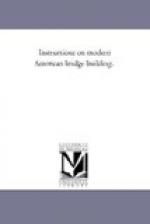Now if we should make a bridge, on the plan of Fig. 3, Pl. I., 75 or 100 feet, or perhaps more, in length, the braces A F and F C, would not only be very long but very large and heavy, and one chief requisite in a good bridge is, to have all the beams so proportioned that they will resist all the strains acting upon them, without being unnecessarily large. It now becomes necessary to have a different arrangement of the parts of the truss in order to obtain increased length of span.
Suppose we have a span, of 40 feet, as represented in Fig 2, Pl. I. Now instead of running the braces from A C until they meet in a point, as before we stop them at a, and c, and place the straining beam, a c, between them to prevent those points from approaching, suspend the points B and D from them, and start the braces B b and D b—and, if the truss were longer, would continue on in the same manner as far as needful. To prevent the. truss from altering its form, as shown by the dotted lines A’ b C’, and A E C, by any passing load, we insert the counter braces marked R.
The braces A a and C c, must support all of the weight of the bridge and its load within the parallelogram B a c D—and the next set of braces, B b and D b, sustain that part of the load which comes over the centre of the bridge. Consequently the braces must increase in size from the centre towards the abutments. The rods resist the same pressure in amount as their braces—but being vertical, do not need the increase, given to the braces on account of their inclination—but increase simply with the strain upon them, from the centre to the ends of the truss.
There are many forms of small bridges differing from those enumerated, in various minor details, but sufficient has been said to give the reader a fair idea of the strains upon the different parts, and how to arrange and proportion the materials to resist them.
PRACTICAL RULES AND EXAMPLES IN WOODEN BRIDGE BUILDING.
In any case that may arise, we must determine approximately the gross weight of the bridge and its load—as a basis, and then we can proceed as follows—in case of a Howe, Pratt, or Arch Brace Truss.
=To find the dimensions of the Lower Chord.=
The tension at the centre of the Lower Chord is found by dividing the product of the weight of the whole bridge and load by the span, by sight times the height—or letting T=tension in lbs., W=weight of bridge and load in lbs., S=span in feet, and h=rise or height—we have
W x S T = ----- --. 8 h
[TeX: $T = \frac{W \times S}{8 h}$]
In this case we have taken the rise at 1/8 of the span, which is evidently the best ratio between those dimensions, as it equalizes the vertical and horizontal forces. As to the proportions of the bays or panels, (or that portion of the truss bounded by two adjacent verticals, as struts or ties, and the chords,) the ratio of the rise (or the vertical distance between the centre lines of the two chords,) and the length on the chord should be such, that the diagonal truss members may make an angle of about 50 deg. with the chords; as the size of the timbers is increased by decreasing the angle, and, if the angle is increased, there are more timbers required.




